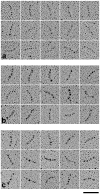The flexibility of two tropomyosin mutants, D175N and E180G, that cause hypertrophic cardiomyopathy
- PMID: 22789852
- PMCID: PMC3412897
- DOI: 10.1016/j.bbrc.2012.06.141
The flexibility of two tropomyosin mutants, D175N and E180G, that cause hypertrophic cardiomyopathy
Abstract
Point mutations targeting muscle thin filament proteins are the cause of a number of cardiomyopathies. In many cases, biological effects of the mutations are well-documented, whereas their structural and mechanical impact on filament assembly and regulatory function is lacking. In order to elucidate molecular defects leading to cardiac dysfunction, we have examined the structural mechanics of two tropomyosin mutants, E180G and D175N, which are associated with hypertrophic cardiomyopathy (HCM). Tropomyosin is an α-helical coiled-coil dimer which polymerizes end-to-end to create an elongated superhelix that wraps around F-actin filaments of muscle and non-muscle cells, thus modulating the binding of other actin-binding proteins. Here, we study how flexibility changes in the E180G and D175N mutants might affect tropomyosin binding and regulatory motion on F-actin. Electron microscopy and Molecular Dynamics simulations show that E180G and D175N mutations cause an increase in bending flexibility of tropomyosin both locally and globally. This excess flexibility is likely to increase accessibility of the myosin-binding sites on F-actin, thus destabilizing the low-Ca(2+) relaxed-state of cardiac muscle. The resulting imbalance in the on-off switching mechanism of the mutants will shift the regulatory equilibrium towards Ca(2+)-activation of cardiac muscle, as is observed in affected muscle, accompanied by enhanced systolic activity, diastolic dysfunction, and cardiac compensations associated with HCM and heart failure.
Copyright © 2012 Elsevier Inc. All rights reserved.
Figures



Similar articles
-
Long-range effects of familial hypertrophic cardiomyopathy mutations E180G and D175N on the properties of tropomyosin.Biochemistry. 2012 Aug 14;51(32):6413-20. doi: 10.1021/bi3006835. Epub 2012 Aug 1. Biochemistry. 2012. PMID: 22794249 Free PMC article.
-
The effect of the Asp175Asn and Glu180Gly TPM1 mutations on actin-myosin interaction during the ATPase cycle.Biochim Biophys Acta. 2012 Feb;1824(2):366-73. doi: 10.1016/j.bbapap.2011.11.004. Epub 2011 Dec 3. Biochim Biophys Acta. 2012. PMID: 22155441
-
Hypertrophic cardiomyopathy-causing Asp175asn and Glu180gly Tpm1 mutations shift tropomyosin strands further towards the open position during the ATPase cycle.Biochem Biophys Res Commun. 2011 Apr 1;407(1):197-201. doi: 10.1016/j.bbrc.2011.02.139. Epub 2011 Mar 3. Biochem Biophys Res Commun. 2011. PMID: 21376702
-
Cardiomyopathy-associated mutations in tropomyosin differently affect actin-myosin interaction at single-molecule and ensemble levels.J Muscle Res Cell Motil. 2019 Dec;40(3-4):299-308. doi: 10.1007/s10974-019-09560-8. Epub 2019 Oct 23. J Muscle Res Cell Motil. 2019. PMID: 31643006 Review.
-
Vertebrate tropomyosin: distribution, properties and function.J Muscle Res Cell Motil. 2001;22(1):5-49. doi: 10.1023/a:1010303732441. J Muscle Res Cell Motil. 2001. PMID: 11563548 Review.
Cited by
-
M8R tropomyosin mutation disrupts actin binding and filament regulation: The beginning affects the middle and end.J Biol Chem. 2020 Dec 11;295(50):17128-17137. doi: 10.1074/jbc.RA120.014713. Epub 2020 Oct 5. J Biol Chem. 2020. PMID: 33020181 Free PMC article.
-
The Effect of Tropomyosin Mutations on Actin-Tropomyosin Binding: In Search of Lost Time.Biophys J. 2019 Jun 18;116(12):2275-2284. doi: 10.1016/j.bpj.2019.05.009. Epub 2019 May 13. Biophys J. 2019. PMID: 31130236 Free PMC article.
-
Predicting Effects of Tropomyosin Mutations on Cardiac Muscle Contraction through Myofilament Modeling.Front Physiol. 2016 Oct 26;7:473. doi: 10.3389/fphys.2016.00473. eCollection 2016. Front Physiol. 2016. PMID: 27833562 Free PMC article.
-
Insights and Challenges of Multi-Scale Modeling of Sarcomere Mechanics in cTn and Tm DCM Mutants-Genotype to Cellular Phenotype.Front Physiol. 2017 Mar 14;8:151. doi: 10.3389/fphys.2017.00151. eCollection 2017. Front Physiol. 2017. PMID: 28352236 Free PMC article. Review.
-
Integration of troponin I phosphorylation with cardiac regulatory networks.Circ Res. 2013 Jan 18;112(2):355-66. doi: 10.1161/CIRCRESAHA.112.268672. Circ Res. 2013. PMID: 23329791 Free PMC article. Review.
References
-
- Brown JH, Cohen C. Regulation of muscle contraction by tropomyosin and troponin: how structure illuminates function. Adv Protein Chem. 2005;71:121–159. - PubMed
-
- Holmes KC, Lehman W. Gestalt-binding of tropomyosin to actin filaments. J Muscle Res Cell Motil. 2008;29:213–219. - PubMed
-
- Li XE, Holmes KC, Lehman W, Jung H, Fischer S. The shape and flexibility of tropomyosin coiled coils: implications for actin filament assembly and regulation. J Mol Biol. 2010;395:327–339. - PubMed
Publication types
MeSH terms
Substances
Grants and funding
LinkOut - more resources
Full Text Sources
Miscellaneous

